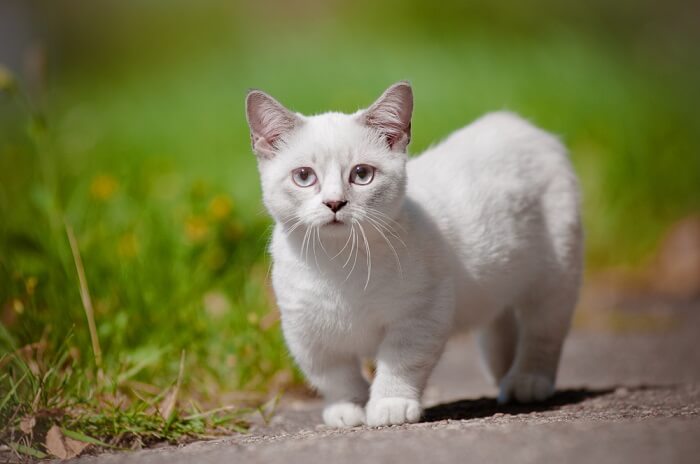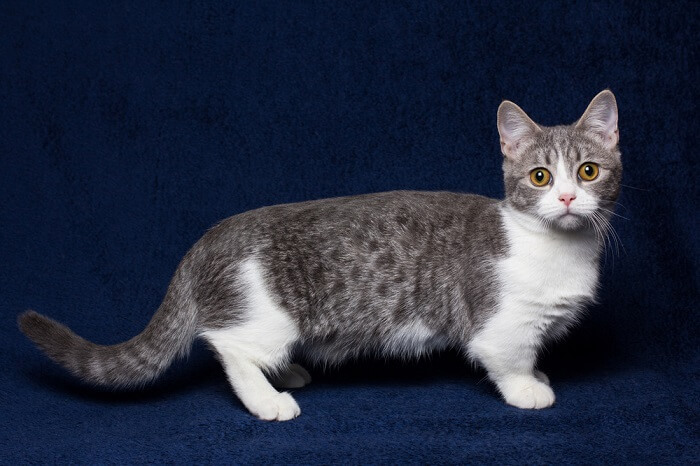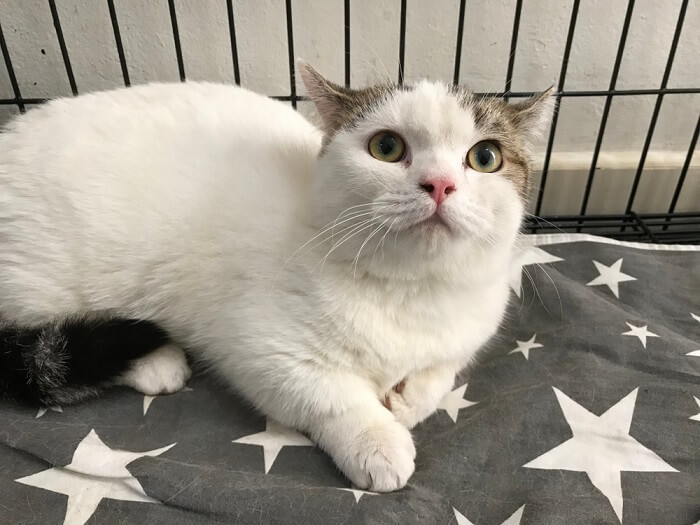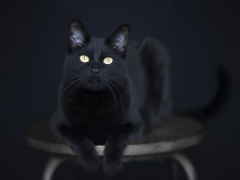
Throughout history, people have valued and bred pets for specific qualities and appearance.
Dwarfism in cats is growing as a class of breeds, but come with potential health risks and considerations. While munchkin and other aptly named breeds may be cute, we should base our pet selection on more than looks for a long and healthy relationship.
Quick Overview: Dwarfism in Cats
 Other Names: Osteochondrodysplasia, achondroplasia
Other Names: Osteochondrodysplasia, achondroplasia
 Common Symptoms: Larger than normal head,stunted jaw, crooked teeth, poor growth, shorter legs compared to body size, enlarged joints, bowing out of the forelimbs, abnormal spine shape.
Common Symptoms: Larger than normal head,stunted jaw, crooked teeth, poor growth, shorter legs compared to body size, enlarged joints, bowing out of the forelimbs, abnormal spine shape.
 Diagnosis: Genetic history, x-rays of limbs and spine, biopsy samples of bone tissue.
Diagnosis: Genetic history, x-rays of limbs and spine, biopsy samples of bone tissue.
 Requires Ongoing Medication: Pain medication if ongoing pain is an issue.
Requires Ongoing Medication: Pain medication if ongoing pain is an issue.
 Vaccine Available: No
Vaccine Available: No
 Treatment Options: Pain medication if cases of painful bone or joint concerns develop. Corrective surgery is often unrewarding. Many cats with dwarfism can lead normal lives. Keeping a cat at an ideal weight is crucial.
Treatment Options: Pain medication if cases of painful bone or joint concerns develop. Corrective surgery is often unrewarding. Many cats with dwarfism can lead normal lives. Keeping a cat at an ideal weight is crucial.
 Home Remedies: Monitoring diet and weight and preventing obesity are important to keep strain off joints.
Home Remedies: Monitoring diet and weight and preventing obesity are important to keep strain off joints.
Causes of Dwarfism in Cats
Dwarfism in cats and dogs can result from hormonal deficiencies, growth plate abnormalities, or can be from a pet chosen for specific size and traits through selective breeding. Genetic mutations and chromosomal abnormalities can cause or contribute to types of dwarfism in cats. These cats often have a shortened life span.
Pituitary Dwarfism
Pituitary dwarfism occurs when the pituitary gland does not form or function correctly. The pituitary, which is a very important gland in the brain, is in charge of regulating many hormones.
Normally, this gland secretes hormones that trigger growth hormones, cortisol, and other essential body functions. If the gland is damaged or does not develop properly, these hormones do not get released, resulting in stunted growth, short stature, poor hair growth, coloring of the skin, as well as serious cardiac and metabolic abnormalities.
These kittens will often be the runt, or much smaller than their litter mates. While this condition is rare in cats, it can be tested for with specific bloodwork, but is very difficult to treat successfully.
Congenital Hypothyroidism

While some cats are intentionally bred to exhibit dwarfism, others are the unintended result of a congenital condition.
Congenital hypothyroidism is another example of a hormonal cause of dwarfism in cats. Congenital means present since birth, and hypothyroid indicates abnormally low levels of thyroid hormones.
The thyroid plays an integral role in the development of the skeletal and nervous system and plays a role in the growth of hair, bones, teeth, along with other body functions. Cats born with this condition are often normal size for the first few weeks, but are then noted to have poor fur growth, short legs and a relative large head, mental dullness, and lethargy.
They can also have problems eating and having normal bowel movements. Testing for this condition requires measuring several of the thyroid related hormones along with general blood tests. Thankfully, this disease is treatable with life-long supplementation of a synthetic thyroid hormone and regular monitoring of bloodwork.
Osteochondrodysplasia
Osteochondrodysplasia describes a problem with the bones and cartilage, resulting in abnormal bone growth. In dwarfism, this means that the growth plates at the end of bones are abnormal or do not close properly.
Since the legs have multiple growth plates, the length and proportion of the limbs are most notable. While not immediately life-threatening, dwarfism as a result of osteochondrodysplasia comes with long-term health problems in cats such as arthritis, pain, decreased range of motion, and mobility issues.
Selective dwarfism occurs when cats are selected for and bred for specific traits related to mature size and weight and proportions of limbs and body. While this type of breeding takes many generations to achieve dramatic changes, it still results in physical traits that put pets at risk. By breeding for shorter limbs, other traits may be selected for by accident, many of which may not be desirable.
Dwarf Cat Breeds
Because of the risks and health consequences related to dwarf cats, most national and international feline groups (such as the International Cat Association) do not recognize or support breeding dwarf cats. Many of the designer dwarf cats are created by breeding a cat with desirable traits with another purebred mate.
Some breed names that may be associated with dwarfism are “munchkin”, “napoleon”, “bambino”, “minskin” and “dwelf”. Certain feline breeds have reported a higher incidence of the metabolic or chondrodystophic forms, specifically Abyssinians and Scottish Folds, respectively.
Health Concerns With Dwarf Cats
Dwarfism that results from a hormonal imbalance, such as low thyroid, requires life-long treatment. The body needs hormones for not only growth, but day to day function as well. Parents of dwarf pets need to be prepared to administer medications daily.
Blood tests and monitoring must also need to be performed regularly, so a good relationship with your veterinarian is essential. Normal life-span for cats ranges from 12-16 years in most cats, but dwarf cats can have a significantly shortened life-span.
In hormonally normal dwarf pets, the major health issues stem from their abnormal limbs and proportions. Part of what makes these pets cute is their short legs under a normal-appearing body, or trunk.

Dwarfism in cats causes a variety of health concerns, including an increased strain on the joints and limbs.
However, this results in a higher strain on their joints and limbs. Over time, these pets can develop osteoarthritis, strains and sprains, and orthopedic conditions such as torn ligaments.
Diagnosing these health issues may require x-rays and other tests. These conditions may require surgery, support, and long-term medications to keep your pet pain free.
Another common condition in dwarf cats is obesity. Cats need regular exercise and stimulation in combination with a well-balanced diet. Dwarf cats may have reduced or limited mobility, which can lead to weight gain.
Unfortunately, this can start a vicious cycle, as increased weight can put more strain on the limbs and accelerate the development of osteoarthritis and joint degeneration.
Back and neurological problems can also develop in cats with dwarfism. These pets are often “sway-backed”, or have a curved spine because of their developmental abnormalities, and their weight and stature. In some cats, this can lead to disk disease and even paralysis in severe cases.
Each cat has their own set of unique traits, which is what makes them endearing and special family members. Dwarf cats and kittens certainly appear even cuter than most, with their short legs and unique physique. But pet parents need to be prepared for the consequences of these traits and the treatments that come with them.
Not all small cats have dwarfism, though!
Adult felines can range from a petite 5 pounds up to massive 20-pound specimens. If you are able to see the mother and father of a kitten, the parental size is the best prediction of growth and mature weight.
There are many cats looking for a home, and the rescue and shelter agencies will help you find the best fit for your family. No matter the size, cats can give an unlimited amount of love!
Frequently Asked Questions
Can dwarf cats have kittens?
It depends. If there are significant hormone abnormalities, a dwarf cat may not be able to become pregnant. Even if they do become pregnant with kitten, a dwarf cat may have difficulty giving birth due to the confirmation of the kittens and the birth canal and pelvis. A C-section may be required in order to ensure the kittens and mother survive.
What kind of cats stay small forever?
Cats can be petite and stay relatively small if their parents were also small.
Why did my cat stay small?
Often stunted growth is a result of serious underlying problems and requires treatment for survival. If your pet is not growing as you expect, the first step is to make an appointment with your veterinarian.
What are dwarf cats called?
Dwarf cats are also referred to as munchkin cats, among other nicknames.








I live in a small suite alone would like a cat as companionship.
Not a large cat but love animals, best company
There are three stray cats around my house they look and act normal, been around for about 4months now. They have not grown much in that time about 4 inches tall, mom is small also but not like them I would like to keep them, but moving in
with my daughter in a month or so and can not. Want to find homes unless are unhealthy but do not seem to be? Seem to be normal -acting and playful.
If you’re able to pick up the kittens, I would recommend taking all of them in for a vet checkup. That’s the only way you can really find out if everything’s okay, and ensuring that they’ve all gotten vaccinations, microchipping, and any spay or neuter operations done will make it easier to adopt them out.